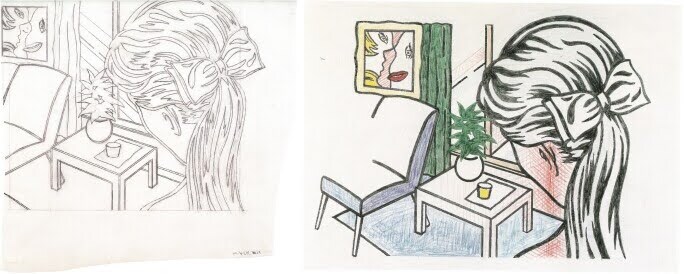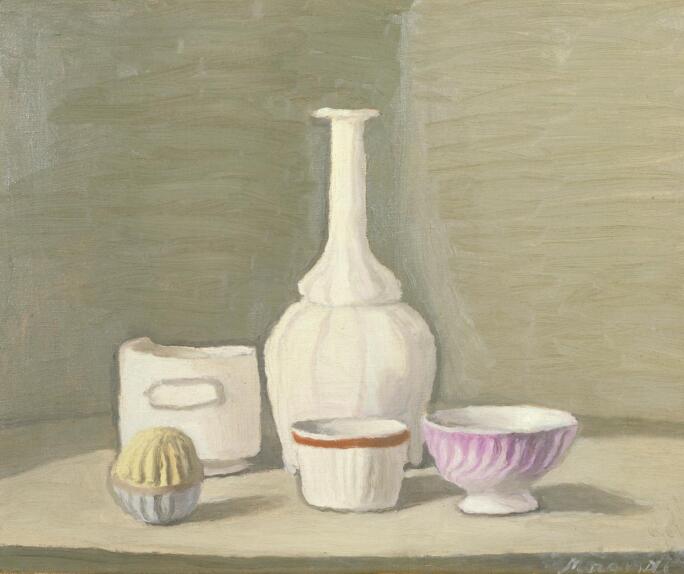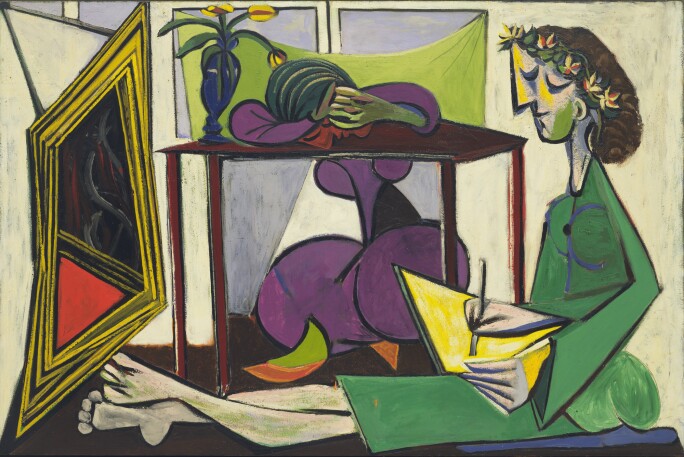
“[Lichtenstein’s] successful sculptures are, to my mind, the best, and the most serious things that he has done, serious in the sense that they recognize an issue of current sensibility—a will to decoration—without resorting to parody… Lichtenstein combines brass, aluminum, marble and tinted glass into ghosts of functional objects, for like primary structures his sculptures evoke utility but do not evoke the object that was useful.”
R adiant in color, crisp in line, and striking in scale, Woman Contemplating a Yellow Cup is a masterwork from Roy Lichtenstein’s final decade, in which the Pop icon pushed the boundaries of sculpture with the same formal daring that revolutionized his painting in the 1960s. Translating the graphic clarity of his canvases into a three-dimensional form, the present work exemplifies Lichtenstein’s genius for spatial illusion and narrative suggestion. The composition is a fusion of sculptural relief and pictorial tableau, combining stylized fragments of a woman, a domestic setting, and an implied gaze. His iconic blonde female figure, rendered in profile with her hair tied in a dramatic bow, leans forward into the picture plane—or perhaps into our space—her attention focused on a single yellow cup poised on a pristine white table. Executed in 1995, this work bears exceptional provenance, coming directly from the collection of Dorothy and Roy Lichtenstein.

Crafted on shaped aluminum, the work projects outward from the wall, flattening sculptural form into a shallow, illusionistic scene while simultaneously emphasizing its objecthood. It is both a picture and an object. The composition compresses spatial cues—perspective lines, shadows, furniture planes—into a puzzle-like array of contours and Ben-Day dots, a nod to the printing processes of mass media that defined Lichtenstein’s signature aesthetic. The table’s angled legs, the chair’s crisp silhouette, and the stylized foliage in the vase all sit in jarring, stylized harmony with the flatly rendered curtain and window frame.
At the heart of the image, the titular yellow cup gleams like a beacon of domestic stillness and meditative pause. It draws the eye with subtle force, a minimalist gesture around which the entire composition seems to orbit. Like the apple in a Morandi still life or the mirror in a Vermeer interior, the cup becomes a surrogate for contemplation, a quiet object imbued with psychological weight. The woman’s gaze—though we see only its orientation, not her eyes—transforms the scene from passive decor to charged encounter.

This blend of psychological nuance and formal stylization was a hallmark of Lichtenstein’s late work, especially his portrayals of women. Revisiting the tropes of 1960s romance comics that catapulted him to fame, Lichtenstein reimagines the female figure not as a caricature of longing or heartbreak but as a complex, self-contained presence. In Woman Contemplating a Yellow Cup, the woman's interiority is suggested rather than spelled out; she is thoughtful, absorbed, private.

While the work references 20th-century advertising tropes and interior design imagery, it also draws from a deeper lineage of modernist art history. The crisp angles and compositional play evoke the precision of Fernand Léger, while the motif of a woman seated in contemplation recalls Picasso’s figures from the 1930s. Simultaneously, the spatial dislocation and pictorial fragmentation situate the work squarely within the postmodern condition, where subjectivity is filtered through mediated image culture.
Woman Contemplating a Yellow Cup exemplifies the technical precision and surface perfection that characterized Lichtenstein's sculptural production. The artist had long experimented with shaped canvases and relief constructions, but these aluminum sculptures from the 1990s mark a culmination of that formal inquiry—rigid, polished, and resolutely graphic. The use of pigmented wax over acrylic adds a subtly lustrous depth, enhancing the visual energy of the surface without compromising its schematic flatness.
Standing as both a summation and evolution of Roy Lichtenstein’s extraordinary visual language, Woman Contemplating a Yellow Cup captures Lichtenstein's enduring fascination with perception, image-making, and the emotional resonance of the everyday object. At once playful and profound, it is a sculpture that mirrors our gaze back at us—inviting us to ponder, to pause, and perhaps, like the woman it depicts, to simply take a moment to contemplate.



